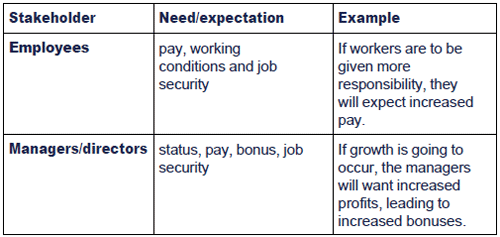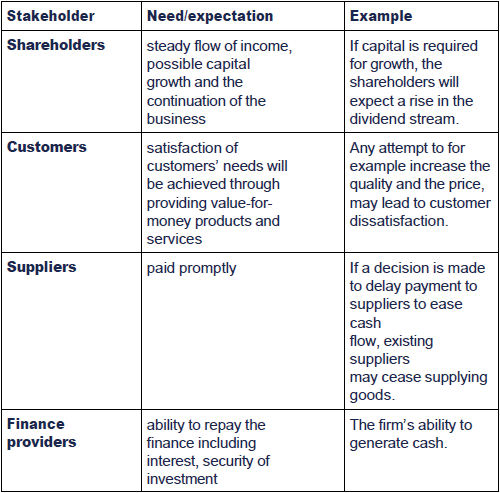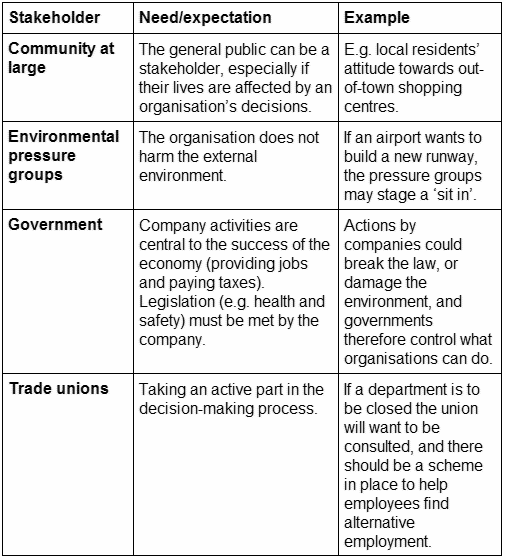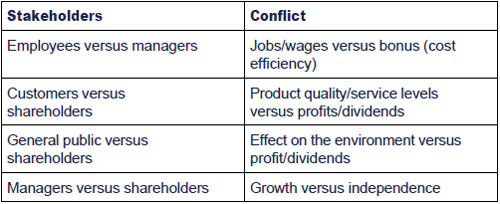Stakeholder analysis
Stakeholder analysis is a key part of formulating an organisation's strategy.
A stakeholder is a group or individual, who has an interest in what the organisation does, or an expectation of the organisation. It is important that an organisation understands the needs of the different stakeholders.
An important part of the strategic manager's job is to understand the contribution that relationships with stakeholders can make to the well-being of the organisation. Assessing the expectations of stakeholders enables an organisation to gauge whether its objectives will provide the means of satisfying the demands of the various stakeholders.
Classification of stakeholders
Stakeholders can be broadly categorised into three groups:
- internal, e.g. employees;
- connected, e.g. shareholders;
- external, e.g.government.
Internal stakeholders
Internal stakeholders are intimately connected to the organisation, and their objectives are likely to have a strong influence on how it is run.
Internal stakeholders include:

Connected stakeholders
Connected stakeholders can be viewed as having a contractual relationship with the organisation.
The objective of satisfying shareholders is taken as the prime objective which the management of the organisation will need to fulfil, however, customer and financiers objectives must be met if the company is to succeed.

External stakeholders
External stakeholders include the government, local authority etc. This group will have quite diverse objectives and have varying ability to ensure that the organisation meets their objectives

Stakeholder conflicts
Examples of conflict
The needs / expectations of the different stakeholders may conflict. Some of the typical conflicts are shown below;

One problem with analysing stakeholders is that they tend to belong to more than one group and will change their groupings depending on the issue in hand, e.g. marketing and production departments could be united against dropping a certain product but be in opposition regarding plans to buy a new product for the range.
Your FeedbackWe value your feedback on the topics or anything else you have found on our site, so we can make it even better.Give Feedback
Resolving conflict
There are a number of ways of resolving stakeholder conflict, including the following:
Cyert and March
Cyert and March suggest four ways to resolve conflicting stakeholder objectives.
- Satisficing involves negotiations between key stakeholders to arrive at an acceptable compromise.
- Sequential attention is when management focus on stakeholder needs in turn. For example, staff may receive a pay rise with the clear implication that it will not be their ‘turn’ again for a few years and so they should not expect any further increases.
- Side payments are where a stakeholder’s primary objectives cannot be met so they are compensated in some other way. For example, a local community may object to a new factory being built on a site that will cause pollution, noise and extra traffic. The firm concerned may continue to build the factory but try to appease the community by also building local sports facilities.
- Exercise of power is when a deadlock is resolved by a senior figure forcing through a decision simply based on the power they possess.
Mendelow
Mendelow developed a matrix to help managers classify stakeholders according to their power and interest with recommendtaion show to mange different groups.
Mission statements
The mission statement is a statement in writing that should describe the basic purpose of an organisation, that is, what it is trying to accomplish. It outlines the broad direction that an organisation will follow and summarises the reasoning and values that underlie that organisation. As such it should help to resolve some conflicts by communicating priorities to stakeholders.
Corporate Governance
One perspective on governance is that it is essentially about ensuring that directors do not put their own interests before those of the shareholders they are supposed to be representing.
Corporate ethics
One way of viewing ethical dilemmas is as stakeholder conflicts - for example, pollution concerns could be expressed as the conflict between trying to make more money for shareholders (e.g. by not spending money to reduce pollution) verses the impact on the wider community. Guidance on ethics and drives to improve corporate social responsibility will help resolve such ethical conflicts.
Corporate ethics is discussed in more detail here.
|
Created at 10/12/2012 11:12 AM by System Account
(GMT) Greenwich Mean Time : Dublin, Edinburgh, Lisbon, London
|
Last modified at 9/11/2013 12:49 PM by System Account
(GMT) Greenwich Mean Time : Dublin, Edinburgh, Lisbon, London
|
|
|
|
 |
Rating
:
|
 Ratings & Comments
(Click the stars to rate the page) Ratings & Comments
(Click the stars to rate the page)
|
 |
Tags:
|
|